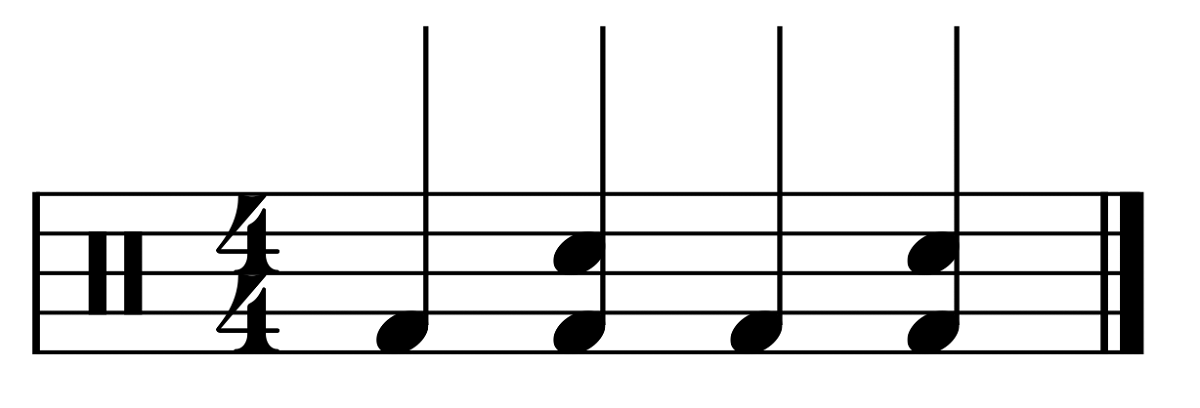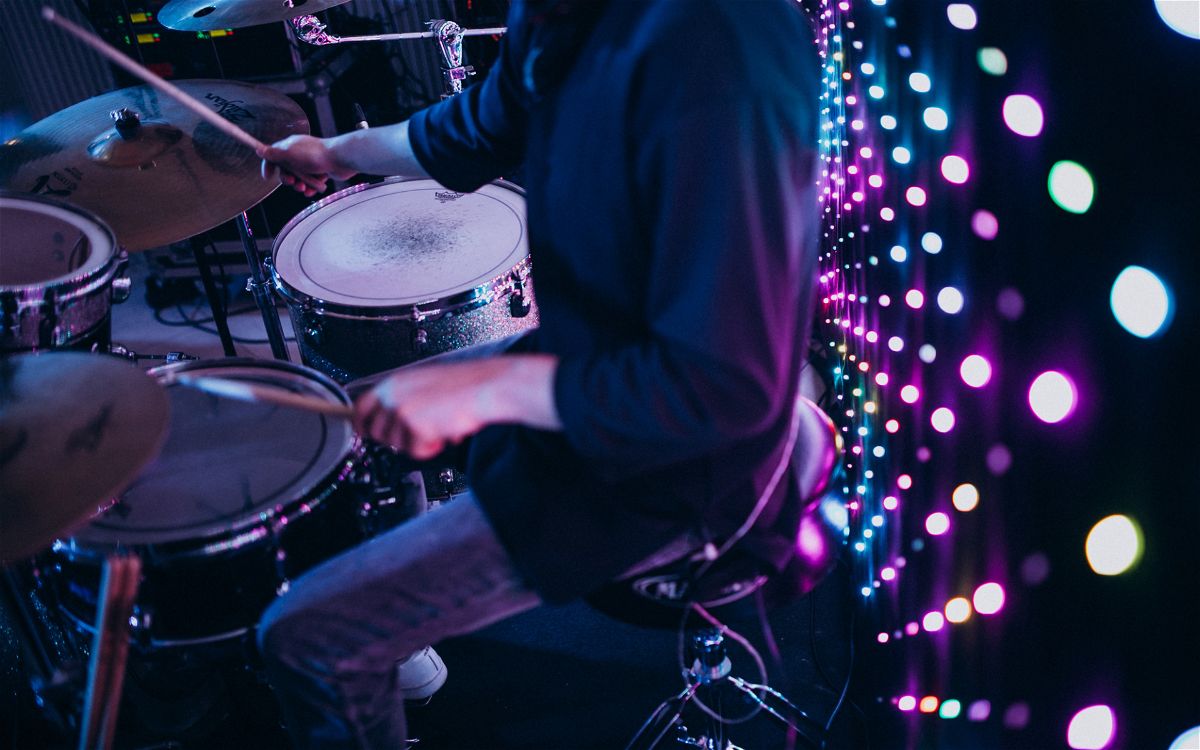Disco grooves are some of the most fun beats to play on the drums. It’s one of those musical styles that is full of energy and vibrance, and the whole point behind most disco beats is to make people dance.
The overall feel of a disco groove is quite simple to grasp, but there are small details to learn that will make your disco beats sound so much better.
I’ve written out ten popular disco drum beats for you to learn. The first few are easy to get a grip on, while the last few are a lot trickier.
If you learn all ten of these important drum beats, you should be able to comfortably play any disco tune.
10 Disco Drum Beats
Disco Drum Beat 1

This first groove is the most simplistic form of a disco drum beat. It’s just quarter notes played on the bass drum and snare drum, and it has a pattern called four on the floor.
Most disco beats have a four-on-the-floor pattern, which is when you play your bass drum on all four quarter note counts in a bar.
You’re then going to play snare drums on beats 2 and 4. Work on playing this groove at multiple different tempos, and you’ll have the general foundation upon which most disco grooves are built.
If you really want to solidify that tight disco feel, aim to dig your bass drum into the beater instead of letting it bounce off the head.
Disco Drum Beat 2

Now, we’re going to add hi-hats to the first drum beat. Most disco grooves are played with the snare drum, bass drum, and hi-hats, with embellishments added here and there.
For this groove, we’re just going to keep the snare and bass drum pattern from the last one, but we’re going to play straight eighth notes on the hi-hat.
You have two ways of playing the hi-hat here. You can play all the notes on the surface to get a gentler sound, or you can play them all on the edge to get more aggression out of the groove.
Try to keep the sounds consistent for this particular beat, though.
This is one of the most popular beginner drum beats with the added flavor of extra bass drum notes.
Disco Drum Beat 3

Once you’ve worked on hi-hat sound consistency, you can move on to alternating how you play the hi-hat to get variations in the sounds.
One of the key elements that a lot of disco drum beats need is a strong offbeat sound. The offbeats are all the “and” counts in the bar, and making those louder creates quite a groovy beat.
The easiest way to create these offbeat accents is by striking the hi-hat on the surface for all the downbeats and then striking the hi-hat on the edge for all the offbeats.
The edge of the hi-hat will naturally give a louder sound, so you don’t even have to focus on hitting harder for the offbeats.
Disco Drum Beat 4

We’re going to keep the snare drum and bass drum pattern for this groove, but we’re going to change the pattern that we play on the hi-hats.
16th note rhythms are also very popular in disco drum beats, so we’re going to play straight 16th notes on the hi-hat.
It’s going to be easier to play faster if you use two hands to play these 16th notes. This means that you’ll need to move your right hand to the snare drum on every second and fourth beat, leaving a hi-hat out for those counts.
If you want to keep the hi-hat playing on beats 2 and 4, you’ll need to use one hand to play the 16th notes, and that will stop you from being able to play the groove as quickly.
Disco Drum Beat 5

We’re now going to play the same groove as the previous one, but you’re going to add those famous offbeat rhythms on all the “and” counts.
Use the same idea that we looked at for Disco Drum Beat 3, striking the hi-hat on the edge for every accent.
This one is going to be a lot trickier to play as your hands are moving between the snare drum and hi-hat now. So, take it very slowly at first, and focus intently on getting the right hand movements going.
Your four-on-the-floor bass drum pattern should be on autopilot by now.
Disco Drum Beat 6

Now, we’re going to move back to playing a simple four-on-the-floor groove with straight eighth notes on the hi-hat.
The added part here is that you’re going to open your hi-hat on the offbeats. This is arguably the most iconic drum beat there is in disco drumming, so it’s a very important one to learn.
While it may seem tricky to open and close your hi-hats while keeping a groove going, there’s a really simple trick to play this groove very easily.
Just press both your feet down on the pedals on every onbeat, and then lift them for every offbeat. Your legs will be matching each other as you play, and then play the simple eighth note rhythms with your hands. The open hi-hat sound should naturally come from this.
Disco Drum Beat 7

Make sure to nail the previous groove before learning this one, as it’s just a more difficult version of it.
The new part here is that you’re going to play consecutive groups of three on the hi-hat for each count. You’re then going to open the hi-hat on the offbeats, meaning that you’ll play two closed hi-hats followed by an open one.
This is one of those disco grooves that sounds amazing when played at a higher tempo. It really drives a song.
You’ll just need to spend a bit of time working on your hi-hat speed techniques to be able to play groups of three quickly.
Disco Drum Beat 8

This groove also has quick groups of three on the hi-hat, but the rhythms have been switched around. Instead of playing three quick notes and then having a rest, you’re going to play one hi-hat stroke, have a rest in between, and then play two quick ones to lead to the next downbeat.
This rhythm isn’t as commonly used in disco beats, but it’s good to work on it so that you have better hi-hat hand control.
Disco Drum Beat 9

This groove is going to have a few added ghost notes with an extra kick drum at the end. Ghost notes are quiet snare drum hits , and they add a bit of musical texture to your grooves.
Fitting in the ghost notes among all the other rhythms can be quite tricky, so make sure to play this groove very slowly when you’re learning.
The extra bass drum note comes on the last offbeat of the bar. This is a common placement for a bass drum in a disco groove, as it gives you three distinct bass drum sounds when you continue to repeat the next bar.
Disco Drum Beat 10

Here’s the most challenging disco drum beat on this entire list. It’s the same groove as the previous one, but you’re now going to open the hi-hat on all the offbeats.
This groove essentially takes every small disco groove idea we’ve looked at and puts it into one great drum beat that is complex and vibrant.
You have ghost notes, extra bass drums, and open hi-hats, all working together to create an exciting disco groove.
Tips for Learning Disco Drum Beats
Work On Your Hi-Hat Techniques
Disco drumming is very hi-hat driven. The best way to equip yourself to play various disco grooves is to get good at playing quick hi-hat patterns. You should also be good at opening and closing your hi-hat, creating splashes and barks.
When you can do that, you’ll be able to play musical disco beats that serve songs very well.
Get Comfortable With Four on the Floor
You should also get comfortable with playing your bass drum and snare drum at the same time. For new drummers, this always feels quite weird.
Once you get used to playing your bass drum on all four counts of a bar, learning new disco drum beats becomes a lot easier. Most of them revolve around four on the floor patterns.
Listen to Disco Music
The best way to immerse yourself in a musical style is by listening to it. Disco music got really popular in the 1970s, so go and listen to all the biggest hits from that period.
You can also find plenty of modern disco-style songs being played by bands like The 1975 and Coldplay.
Conclusion
Remember to use a metronome when working on all these grooves. Make sure to practice them at varying tempos, and make sure to get comfortable with playing them at higher tempos than normal.
Most disco music is very upbeat, so the beats are fast and energetic. If you want to know which drum kits work best for disco grooves, you’ll find that standard kits with powerful 22” kick drums work very well.









